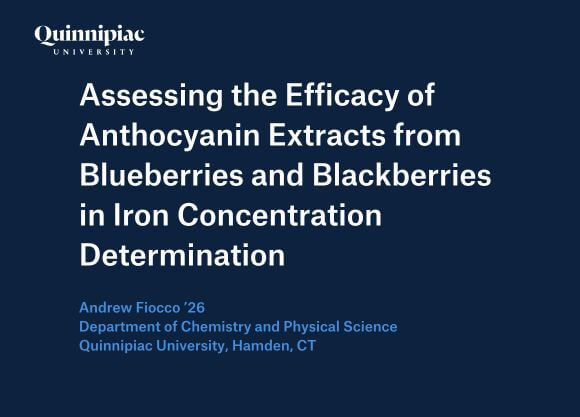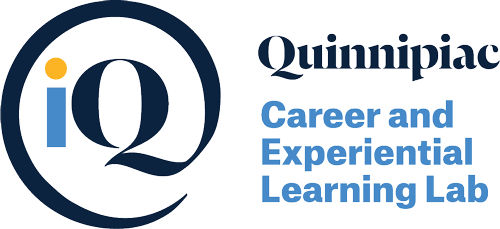QUIP-RS
Assessing the Efficacy of Anthocyanin Extracts from Berries

QUIP-RS
Assessing the Efficacy of Anthocyanin Extracts from Berries
Andrew Fiocco ’26 conducted this study to further understand practical methods to measure iron concentrations for resource-limited environments.
Overview
This study looks at the quantitative response of anthocyanins to iron (II) and iron (III) found in blueberries and blackberries.
Award Winner
- Best undergraduate presentation in the chemistry category, Sigma Xi – IFoRE (International Forum on Research Excellence) November 14-17, 2024
Researcher

Andrew Fiocco '26
Biochemistry
College of Arts & Sciences
Assessing the Efficacy of Anthocyanin Extracts from Blueberries and Blackberries in Iron Concentration Determination
Introduction
- Excessive iron (Fe) content in water (> 0.3 mg/L) can impact health of ecosystems, humans.1
- Current methods of measuring iron include instrumental (e.g. Atomic absorption spectroscopy3) and colorimetric (e.g., 1,10-phenanthroline4) techniques.
- These methods, while effective, are problematic due to high cost, risk to operator, and high environmental impact.
- Anthocyanin extracts from plant sources can form complexes with Fe; these complexes absorb at a higher wavelength than the anthocyanin.
- Most previous work has focused on plant sources native to Southeast Asia.5-7
- Blueberries (Vaccinium corymbosum L.) and blackberries (Rubus fruiticosus L.) contain high amounts of anthocyanins.8
- Goals of this project:
- Assess how well extracts from blackberries and blueberries quantify both Fe2+ and Fe3+.
- Compare the sensitivity of extracts to Fe2+ and Fe3+ over a range of pH.
Methods
- Fe2+ and Fe3+ stock solutions were prepared using ferrous ammonium sulfate ((NH₄)₂Fe(SO₄)₂·6H₂O) and ferric ammonium sulfate (NH₄Fe(SO₄)₂·12 H₂O) (Fisher Scientific)
- Fe2+ and Fe3+ standards were prepared in ultrapure water with concentrations ranging from 0-40 mg/L.
- Anthocyanins from blackberry and blueberry samples extracted using ultrapure water at 90°C for 15 minutes.
- Extracts, diluted with buffer (acetate for pH 4-5.5, phosphate for pH 6-7), were added to each iron standard in a 1:2 (v/v) standard-extract ratio.
- Maximum absorbance values at λmax measured (using Agilent Cary 3500 spectrophotometer) for blueberry, blackberry extracts before, after complexation with Fe standards at pH 4-7.
- After determining optimal pH for sensitivity, iron supplement tablets (NatureMade) were digested with 6 M HCl. The digested tablet was filtered, diluted and reacted with each extract. Iron concentration was determined from calibration curves.9
Future Work
- Establish usable Fe concentration ranges for blackberry extracts.
- Use blackberry extracts for quantification of other heavy metal species (such as Cu2+, Al3+, and Pb2+)
- Work on producing purer and more concentrated extracts to maximize sensitivity to both forms of Fe.
- Apply this method to measure metal concentrations in soil samples.
- Assess the efficacy of other native extracts that may be more abundant in anthocyanins known to complex with Fe, other metals.
Professional Application
“My career goal is to become a cardiothoracic surgeon, so this project and QUIP-RS helped significantly with developing my public speaking, presentation-making and interpersonal skillsets. It has also helped me gain more insight into how scientific research and publication is typically conducted. Furthermore, as a pre-medical student, many medical colleges want to see an abundance of research experience in their applicants, therefore my participation in the project and the QUIP-RS program has prepared me significantly for my eventual application to medical school. From my participation in the project, I am also eligible to travel to and present at national and international scientific conferences, which will not only bolster my future medical school application, but will also give me more opportunities to develop my public speaking skills and will give me an opportunity to network with nationally renowned scientific figures.” – Andrew Fiocco '26
Learn more about Sigma Xi's 2024 International Forum on Research Excellence (IFoRE)
Faculty Mentor
For Further Discussion
This serves as an overview of the project and does not include the complete work. To further discuss this project, please email Andrew Fiocco.
Quinnipiac University Interdisciplinary Program for Research and Scholarship
Open to students of all majors, QUIP-RS provides up to $5,000 in funding for undergraduate students to conduct research or complete creative projects alongside faculty mentors. This intensive 8-week program enables students to develop scholarly skills while encouraging discussion about successes and shortcomings with fellows and mentors.
Explore Our Areas of Interest
We've sorted each of our undergraduate, graduate and doctoral programs into unique Areas of Interest. Explore these categories to discover which programs and delivery methods best align with your educational and career goals.
Explore Health and Medicine Programs at Quinnipiac
Explore Physical and Life Sciences at Quinnipiac
Explore STEM Programs at Quinnipiac
References
- United States Environmental Protection Agency. 2015 Sep 3. Drinking Water Regulations and Contaminants. https://www.epa.gov/sdwa/drinking-water-regulations-and-contaminants. [accessed 2024 Mar 23]
- E. Allan, The determination of iron and manganese by atomic absorption, Spectrochimica Acta, 15, 800-806, 1959.
- Milne, A., Landing, W., Bizimis, M., and Morton, P. Determination of Mn, Fe, Co, Ni, Cu, Zn, Cd and Pb in seawater using high resolution magnetic sector inductively coupled mass spectrometry (HR-ICP-MS). Analytica Chimica Acta. 665(2), 200–207, 2010. doi:10.1016/j.aca.2010.03.027.
- Saywell, L. G. and Cunningham, B. B. 1937 Feb 1. Determination of Iron: Colorimetric o-Phenanthroline Method. Ind. Eng. Chem. Anal. Ed., 9, 67-69, 1937.
- Meelapsom R, Rattanakaroonjit W, Prakobkij A, Malahom N, Supasorn S, Ruangchai S, and Jarujamrus P. 2022. Smartphone-Assisted Colorimetric Determination of Iron Ions in Water by Using Anthocyanin from Ruellia tuberosa L. as a Green Indicator and Application for Hands-on Experiment Kit. J. Chem. Educ., 99, 1660-1671, 2022. doi:10.1021/acs.jchemed.1c01120.
- Khaodee, W., Aeungmaitrepirom, W. and Tuntulani, T. Effectively simultaneous naked-eye detection of Cu(II), Pb(II), Al(III) and Fe(III) using cyanidin extracted from red cabbage as chelating agent. Spectrochimica Acta Part A, 126, 98–104, 2014, doi:10.1016/j.saa.2014.01.125.
- Jaikrajang, N., Kraunetr, S., Harding, D. J., and Rattanakit, P. A simple flow injection spectrophotometric procedure for iron (III) determination using Phyllanthus emblica Linn. as a natural reagent. Spectrochimica Acta Part A, 204, 726–734, 2018, doi:10.1016/j.saa.2018.06.109.
- Wu, X,, Beecher, G. R., Holden, J. M., Haytowitz, D. B., Gebhardt, S. E., and Prior, R. L. Concentrations of Anthocyanins in Common Foods in the United States and Estimation of Normal Consumption. Journal of Agricultural and Food Chemistry, 54, 4069–4075, 2006.
- Atkins, R. C., Colorimetric determination of iron in vitamin supplement tablets. A general chemistry experiment, J. Chem. Educ., 52, 550, 1975.
